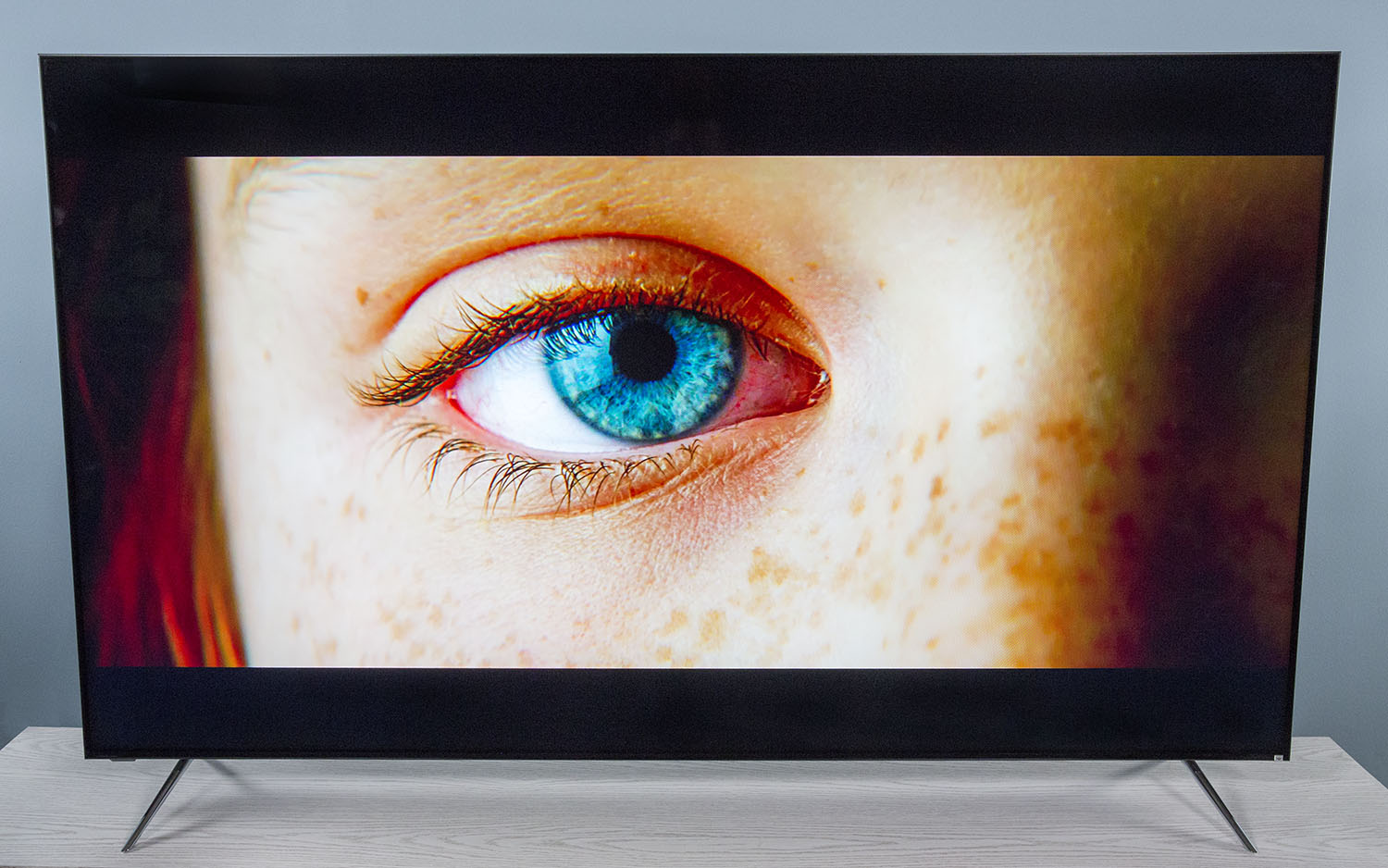Tom's Guide Verdict
The Vizio P-Series Quantum PQ65-F1 is a good first effort for a quantum-dot LCD TV, but it doesn't quite match the premium competition.
Pros
- +
Quantum-dot display offers vibrant color
- +
Local dimming offers deep blacks and brighter brights
- +
Vizio's SmartCast has Google Chromecast built in
Cons
- -
Prone to serious haloing
- -
No subwoofer
- -
No voice control without a secondary device.
Why you can trust Tom's Guide
Vizio's latest TV is more than just a high-end version of the company's SmartCast TVs. The Vizio 65-inch P-Series Quantum PQ65-F1 ($2,099 as tested) is an attempt to step up to the next weight class, taking a shot at Samsung's QLED TVs with a quantum-dot LCD display that offers brilliant color and brightness at more affordable prices. While the company hopes that the P-Series Quantum will plant Vizio's flag in the premium TV space, the reality is that the PQ65-F1 is a very good TV that still needs some refinements to effectively compete with heavyweights like Samsung and LG.
Editor's Note (Nov. 9, 2018): Due to an error in our testing, the brightness levels we originally quoted were incorrect. This review has been updated to reflect this change. The rating remains unchanged.
Vizio P-Series Quantum Cheat Sheet: What You Need to Know
- The quantum-dot display and 192 dimming zones deliver vivid colors and deep black levels, but has distracting light blooms.
- Five HDMI ports give you plenty of connections, and ARC support for connecting a soundbar.
- Sound quality is clear, but lacking in bass. We recommend adding a soundbar.
- There's no voice assistant, but you can pair the TV with Google Home or Amazon Alexa devices.
- Vizio's SmartCast platform is great for mobile users, thanks to built-in Google Chromecast, but the local app selection is sparse.
- While it's a very good TV, the Samsung Q8FN QLED TV delivers better picture and sound, with a more refined quantum-dot-enhanced display that rivals OLED.
Vizio 65-inch P-Series Quantum PQ65-F1 Specs
| Price | $2,099 |
| Screen Size | 65-inches |
| Resolution | 3840 x 2160 |
| HDR | HDR10, HLG, Dolby Vision |
| Refresh Rate | 120Hz |
| Ports | 5 HDMI, 1 USB |
| Audio | 2 channel 10 watt |
| Smart TV Software | SmartCast with built-in Chromecast |
| Size | 56.96 x 32.72 x 2.72 inches [w/o stand] |
| Weight | 54.6 pounds [w/o stand] |
The P-Series Quantum is Vizio's top-of-the-line model, and as such gets some of the best stylings available. The set sports very narrow bezels, a pair of gleaming metal feet, and a textured metal accent runs along the right- and left-hand edges of the display. The set is Vizio's first quantum-dot display, and the company has hedged its Quantum bet by offering the P-Series Quantum only in the 65-inch size.
Measuring 56.96 x 32.72 x 2.72 inches, the P-Series Quantum is thicker throughout than some competitors, like the Samsung 65-inch Q8FN QLED TV (2.3 inches) and LG 65SK9500 Super UHD 65-Inch (2.5 inches), but not dramatically so. On the back, you will find holes for a 400 millimeter x 200 millimeter VESA mount, letting you attach the TV to a wall mount or mounting arm.
Ports
One area where the P-Series Quantum really delivers on its premium promise is the inclusion of 5 HDMI ports, giving you plenty of connectivity for all of your devices, from satellite or cable boxes to game consoles and Blu-Ray players.
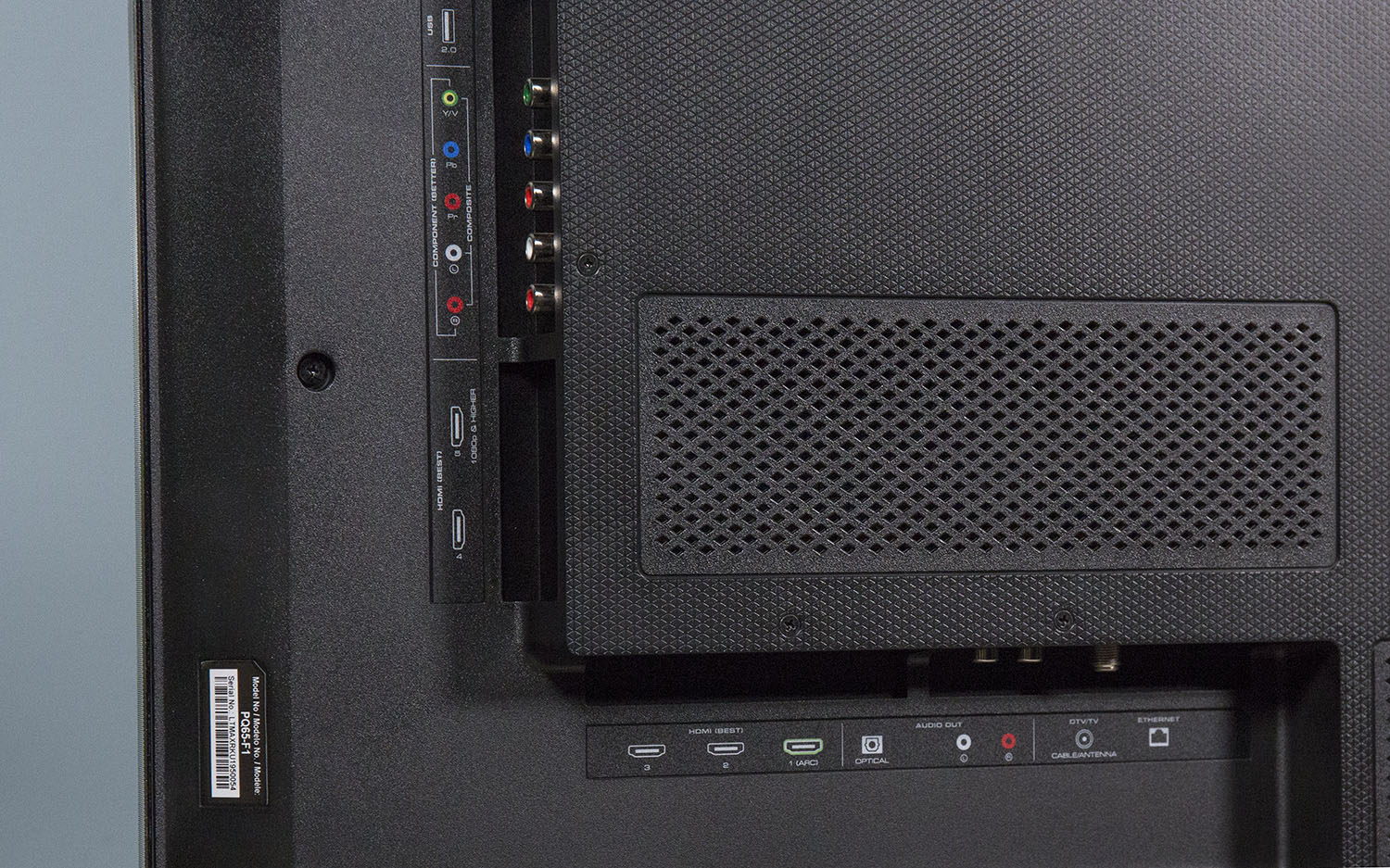
Port connectors face to the right and downward in back, but Vizio uses an open design that leaves the ports very accessible. On the right side, in just a few inches from the edge of the display, you will find two HDMI ports, component and composite video inputs and a single USB port.
The downward-facing ports, which are further in back of the set, include three additional HDMI ports (including one with ARC support), outputs for both digital surround sound and right and left audio, along with an RF connector for cable and antenna.
MORE: Our Favorite Smart Home Gadgets and Systems
There's also an Ethernet port for wired networking connection, and the TV is equipped with 802 11ac Wi-Fi.
Performance
Vizio's premium play centers on the display, a 65-inch LCD panel enhanced with quantum-dot technology for better brightness and color. It's the same tech that puts the "Q" in Samsung's QLED TVs, but Vizio takes it a step further with 192 dimming zones. The end result is a display that offers brighter brights, deeper darks and more vivid color than a standard LCD panel, but Vizio still has some work to do to catch up with the competition.
| Row 0 - Cell 0 | Color Gamut (Percentage, Higher is Better) | Color Accuracy (Delta-E Rating, Lower is Better) | Max Brightness (Nits, Higher is Brighter) |
| Vizio 65-inch P-Series Quantum PQ65-F1 | 99.92 | 2.79 | 2340 |
| LG 65SK9500 | 99.96 | 3.05 | 1555 |
| Samsung Q8FN QLED TV | 99.98 | 2.51 | 1926 |
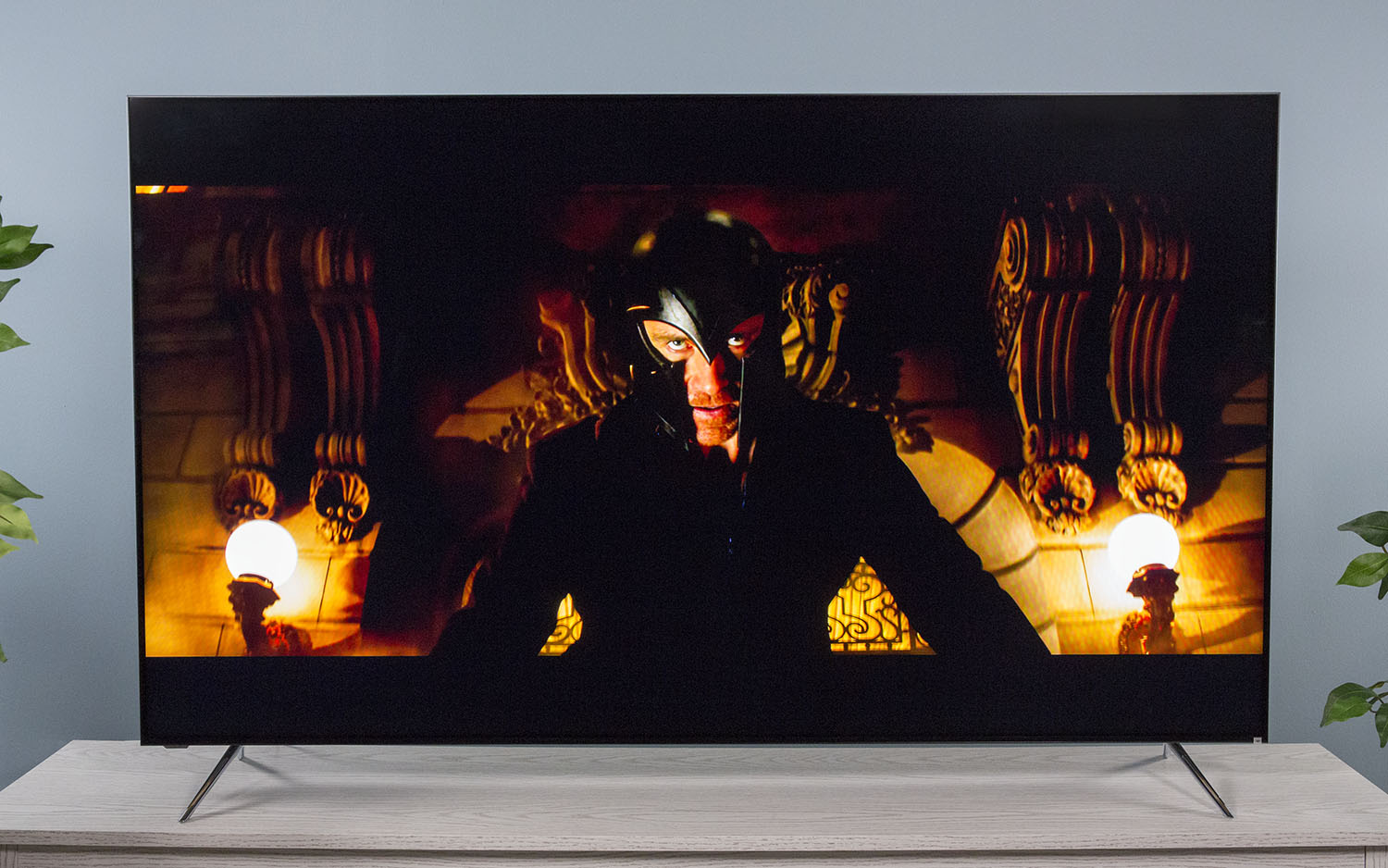
However, the backlighting is not perfect, and individual lighting zones can be distinguished when viewing several small bright points on dark backgrounds. For example, watching Blade Runner 2049, a shot of sparks flying up from a fire set against a black sky was filled with small but noticeable halos as the many dimming zones struggled to illuminate individual sparks in the surrounding blackness. The numerous dimming zones are prone to adding unwanted flaring and darkening around some on-screen elements, and it's actually more noticeable than you might get with other local-dimming displays. Other manufacturers minimize this effect with special light- bloom algorithms (which help contain the illumination to the desired area), but Vizio's backlighting doesn't seem to be as precise.
Shadowing in the corners of the display is very minor, but we did see some very subtle vertical bands of shadow across the screen. It's not enough to be noticeable under normal viewing conditions, but it was enough to be seen during our more rigorous single-color- screen tests.
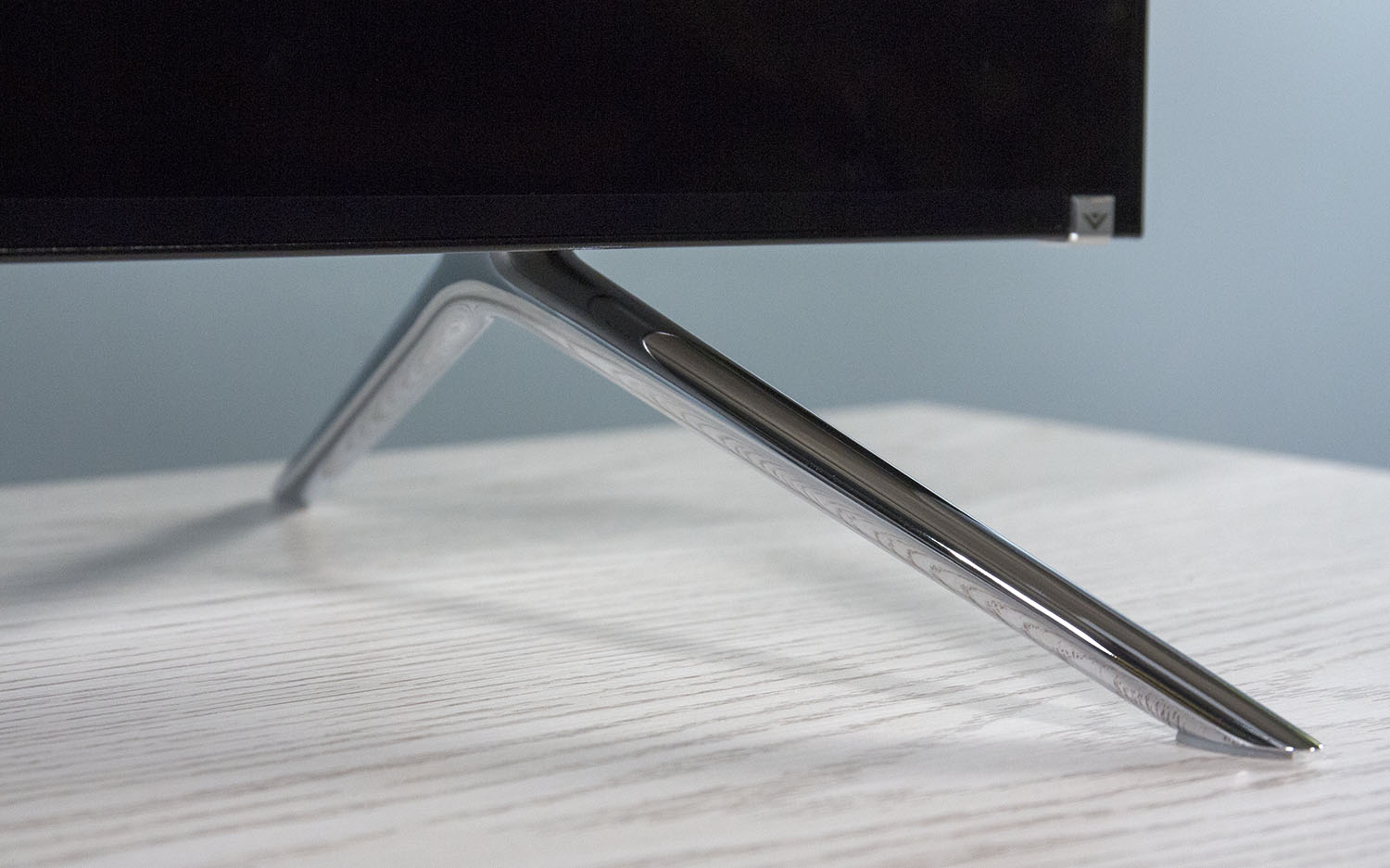
Subtle distinctions between similar shades of color could result in some banding on the Vizio. A night scene bathed in blue light in Blade Runner 2049 resulted in distinct posterization issues as the display struggled with several similar shades of blue. However, in most viewing, even when displaying difficult subtleties of tone, the Vizio did quite well.
The set reproduced 99.92 of the Rec. 709 color space when tested in our lab. That's close enough to 100 percent for our liking, though it's a fraction of a percent behind competing sets, like the LG 65K9500 (99.96) and the Samsung Q8FN QLED TV (99.97 percent), making for a negligible difference.
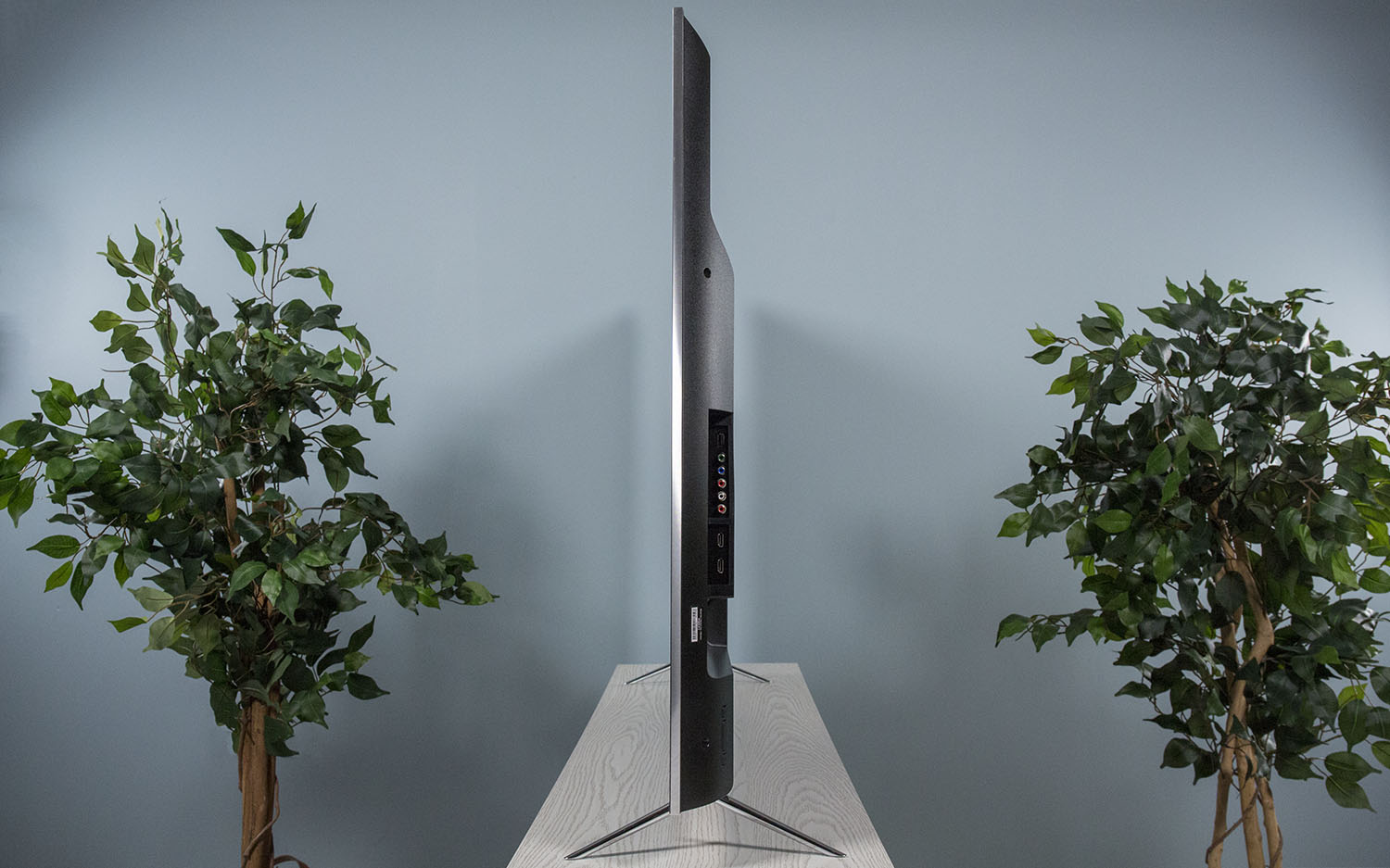
Color accuracy was very good, with a Delta-E rating of 2.8 (closer to zero is better). While that's slightly less accurate than we saw on Vizio's non-quantum P65-F1 (2.0), it's on a par with the Samsung Q8FN QLED TV (2.5) and better than the LG 65SK9500 (3.0). The accuracy of color lends itself especially well to displaying skin tones. In both Blade Runner 2049 and Spider-Man: Homecoming, close-ups of faces had realistic variations in tone, and looked extremely lifelike.
Viewing angles are somewhat limited, with mild color-shifting at the edges of the screen when viewed from only a foot off center. Vertical viewing angles are similarly constrained, and standing up from the couch caused significant color shifting along the bottom edge of the screen. Watching from a lower position, such as sitting on the floor, produced similar color distortion. This TV will look great from a front- and center-viewing position, but anything at an angle will have some color issues.
MORE: Best Cheap 4K TVs (Under $500), Ranked from Best to Worst
Connecting our Xbox One X to the TV, we were able to game in 4K, but the set didn't offer gaming with HDR or 10-bit color without adjusting the input settings on the TV. To get full HDR and color support, you'll need to enable HDMI 2.0 input for the HDMI port you use to connect the console. It's a real irritation having to jump through extra hoops for full functionality, but at least it's available to you. The light-blooming issues were also quite pronounced in the Xbox menus, where white lettering was surrounded by dramatic halos of unwanted brightness.
Audio
The P-Series Quantum has the best display Vizio's ever made, but the audio that's built into the set isn't as impressive. The TV has a pair of 10-watt speakers, which provides a fair amount of volume, but with no subwoofer to provide extra oomph, the bass levels offered on the TV are fairly weak. When sets like the Samsung Q8FN offer 4.1 sound, the stereo sound seems rather pedestrian, and the lack of proper bass was simply disappointing.
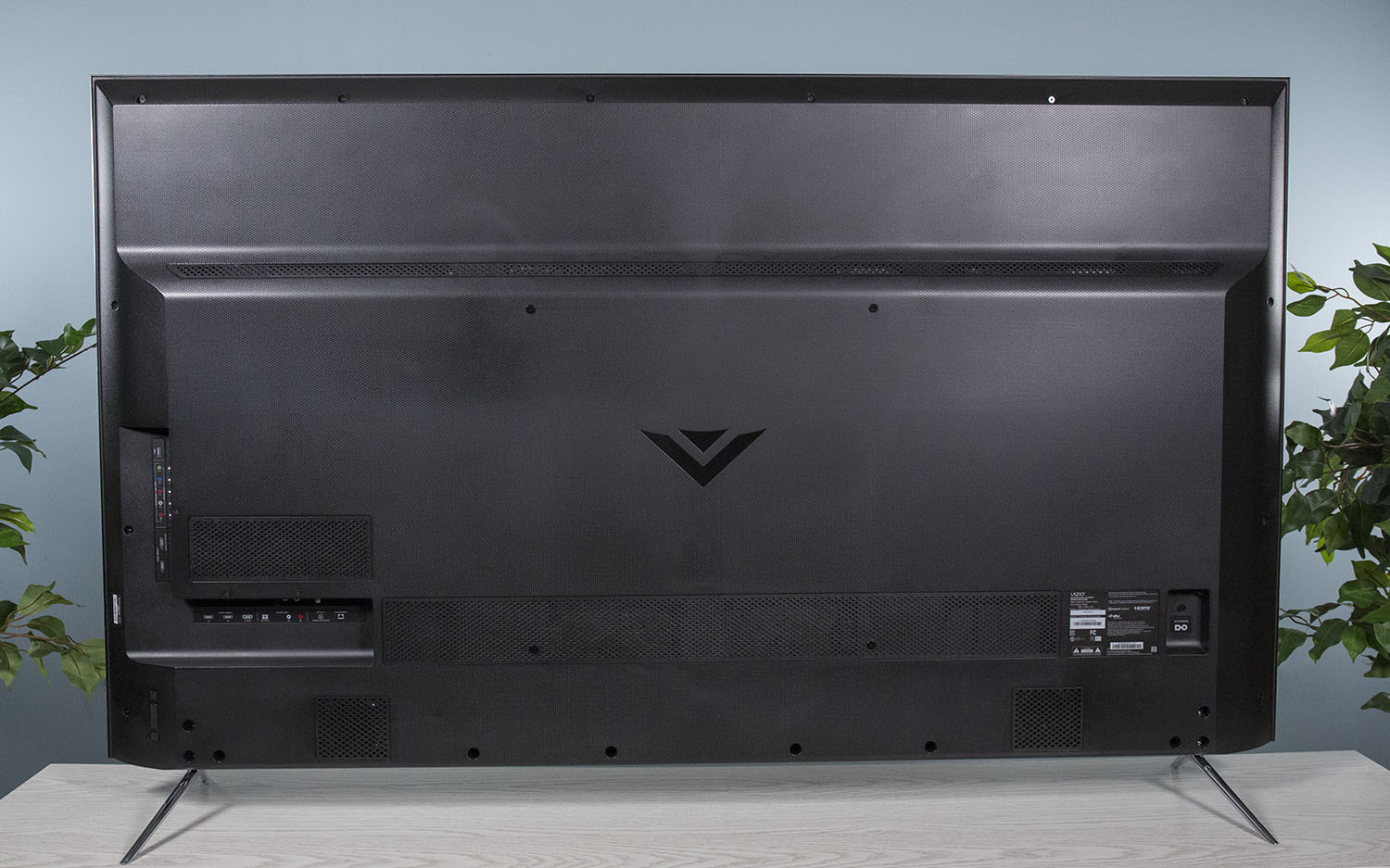
The P-Series Quantum has the best display Vizio's ever made, but the audio that comes built into the set isn't quite as impressive.
Listening to the bass-heavy "My Blood" by Twenty One Pilots, the pounding bassline was dramatically reduced. Other ranges came through clearly, with fairly clear vocals and instrumentals.
Smart Features
Vizio's SmartCast operating system has always had its limitations, with a heavy reliance upon built-in Google Chromecast functionality for most apps. In current iterations, the SmartCast platform has been updated to include 22 locally installed apps; however, it's still a very limited selection.
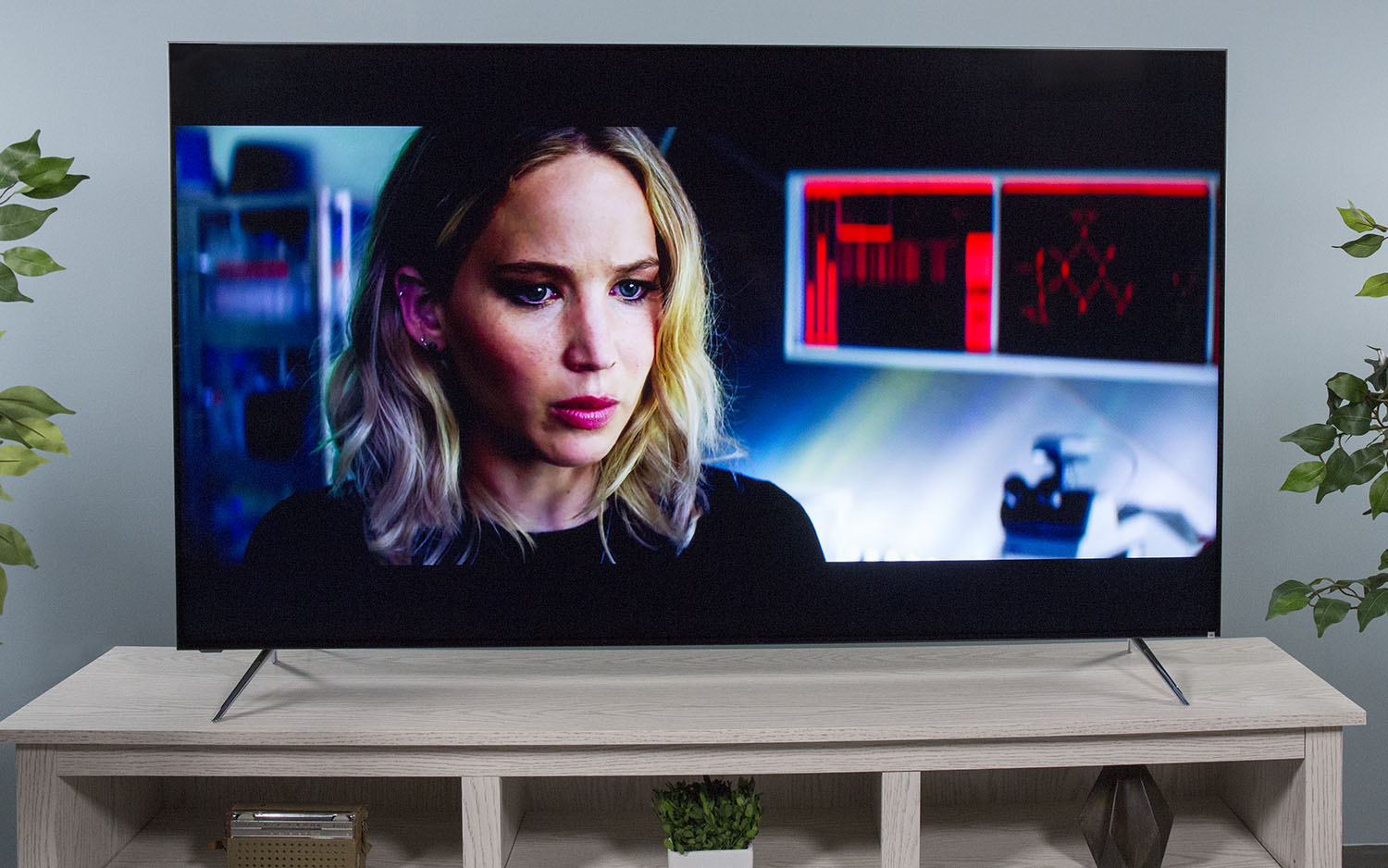
One unique offering on Vizio's current TVs is an app called WatchFree. It consists of several linear content channels showing movies and news, pulled from Pluto TV. It comes preinstalled on the set and is ready to watch as soon as you're connected to the internet. However, the channel selection is largely identical to the Pluto TV free streaming app, which also comes installed on the TV.
Apps listed on the home screen include Netflix, Amazon Prime Video, WatchFree by Vizio, Hulu, Vudu, iHeartRadio, Xumo, YouTube, YouTube TV, CBS All Access, NBC, newsy, Fandango, Crackle, Haystack TV, Dove Channel, CuriosityStream, ToonGoggles, Pluto TV, Baeble Music, ConTV, Plex and a tile for selecting USB input. Additional apps are only available through a separate phone or tablet via built-in Google Chromecast.
MORE: Best Smart TVs - The Best 4K and HD Televisions for the Money
Unlike most competing manufacturers, Vizio doesn't have any sort of voice-search capability built into the PQ65-F1, but it's less of an issue with no web browser and no app store on the TV. Instead, you can access these sorts of features through your phone, or you can add a Google Home or Amazon Echo for voice control functionality – the PQ65-F1 is compatible with both.
Remote control
The Vizio remote remains unchanged from previous models, with a rectangular shape and curved oval profile that offers a comfortable curve in the hand. The remote includes a large square directional pad for navigating menus, volume and channel control buttons, number buttons and media playback controls.
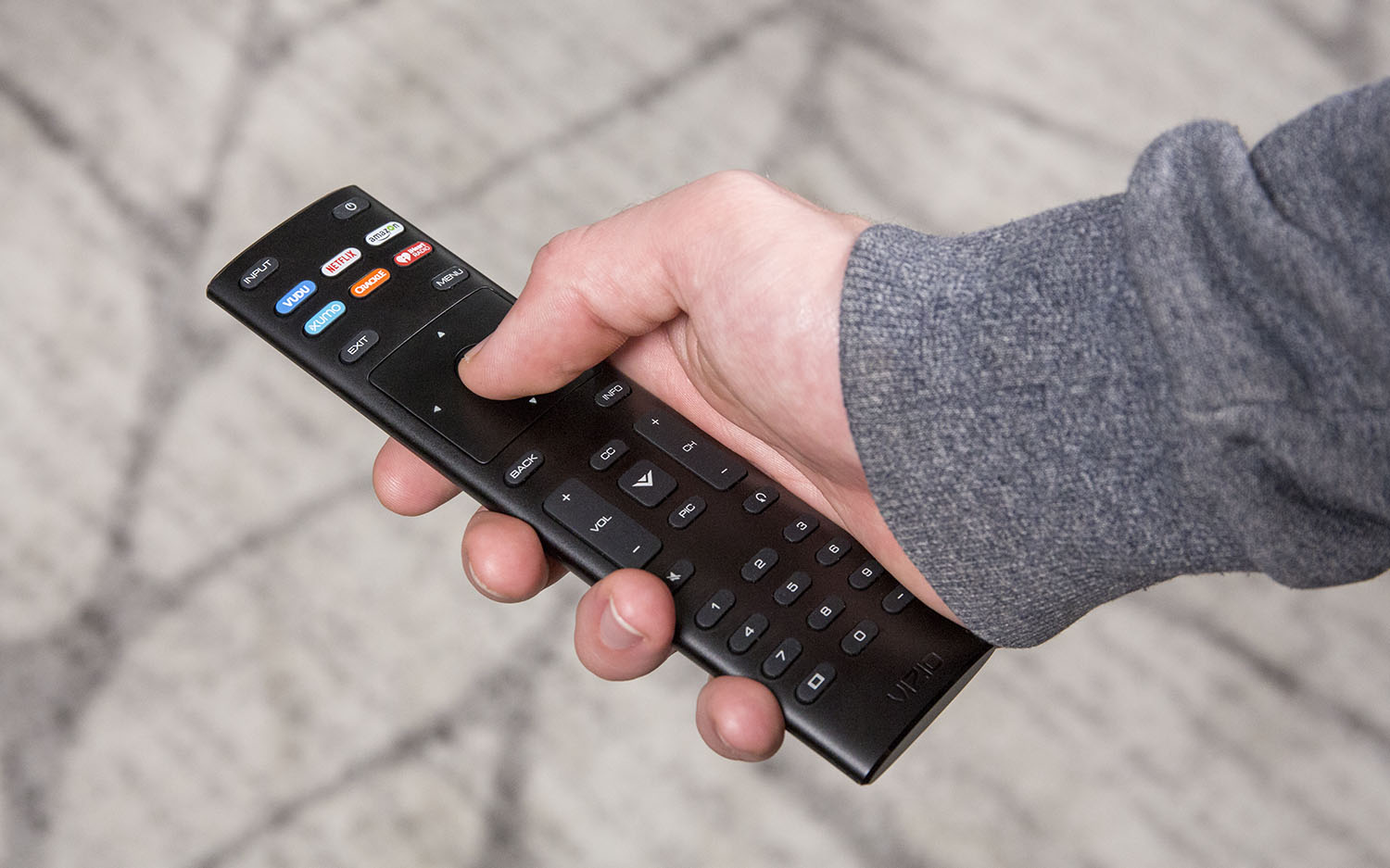
At the top are six dedicated app buttons. These preprogrammed buttons give you one-touch access to several popular or promoted apps, specifically Amazon Prime video, Crackle, Netflix, Vudu and Xumo for streaming video and iHeartRadio for streaming music. Unlike most remote controls, the Vizio design puts these buttons in a prominent position, making them difficult to ignore.
Bottom Line
After testing and comparing the Vizio P-Series Quantum PQ65-F1 to other sets in the same class of size and price, it's clear that Vizio has the potential to deliver a great premium set, but it's not quite there. The quantum-dot display is an impressive step forward for Vizio, but it's held back by overaggressive backlight and is paired with less-than-premium audio. Vizio's SmartCast platform also has its limitations, and lacks common premium features, like voice search.
For a superior quantum-dot experience, the Samsung Q8FN QLED TV offers a better picture and more impressive sound, and it sells for only a bit more at $2,299. If you're a Vizio fan, we actually prefer the Vizio P-Series 65-Inch P65-F1, which has no quantum-display tech, but also doesn't have the same backlighting issues. It also sells for much less, at $1,199.
Credit: Tom's Guide
Brian Westover is currently Lead Analyst, PCs and Hardware at PCMag. Until recently, however, he was Senior Editor at Tom's Guide, where he led the site's TV coverage for several years, reviewing scores of sets and writing about everything from 8K to HDR to HDMI 2.1. He also put his computing knowledge to good use by reviewing many PCs and Mac devices, and also led our router and home networking coverage. Prior to joining Tom's Guide, he wrote for TopTenReviews and PCMag.
-
danno1964k6 How can you even suggest to go with the Samsung Q8 for more money when there is no comparison?Reply
The Quantum has double the contrast with local dimming coming close to the Q9 and also double the SDR and HDR brightness than the Q8.
Not to mention the Q8 has something like 60 zones to 192 of the Quantum.
I own right now the P75F1 120 zones that has better blacks and minimal blooming than the Q8 for less the price.
The Q9 is almost double the Quantum withe similar specs.
It's a no brainer!!
All LG LCD tv's can't even touch the PF1 series let alone the Quantum.
LG LCD tv's are over priced like the Samsung and have horrible blacks and vertcal blooming.
It's about time someone takes out the over priced and over rated Sony, Samsung and LG, which I have owned all 3 2017 and 2018 models.
This years Vizio is the clear winner for half the price among it's competitors! -
danno1964k6 My only delema is that I just purchased the P75F1 for 2500.00 Canadian on sale at Costco and they just introduced the P Quantum series for 2999.00 Canadian.Reply
I know if I wait, the price will drop, and do I get the Quantum instead!
The P75 has great blacks and is great for night time watching with all lights off, and especially movies with dark scenes look great.
If you raise the color to about 80, the colors become even more alive.
There is very minimal haloing unlike the bad blooming the Sony 900E and F have for the same price as the P75.
We know all tv's have issues, just which ones are you willing to except.
OLEDS are great for blacks but some have bad DSE or banding, and get "BURN IN" , who wants to tip toe with there investment like OLED on being careful how long you watch something, you might as well throw your money away.
There is no perfect tv!
Just pick the best bang for your dollar tv with the issues you are willing to deal with! -
vaughncampbell Very poor review and it goes against what the real experts are saying. When you claim that the q8fn is a better choice that proves that you dont know what you are talking about.Reply
